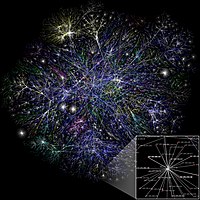
Photo from wikipedia
Abstract Structural balance in social network theory starts from signed networks with active relationships (friendly or hostile) to establish a hierarchy between four different types of triadic relationships. The lack… Click to show full abstract
Abstract Structural balance in social network theory starts from signed networks with active relationships (friendly or hostile) to establish a hierarchy between four different types of triadic relationships. The lack of an active link also provides information about the network. To exploit the information that remains uncovered by structural balance, we introduce the inactive relationship that accounts for both neutral and nonexistent ties between two agents. This addition results in ten types of triads, with the advantage that the network analysis can be done with complete networks. To each type of triadic relationship, we assign an energy that is a measure for its average occupation probability. Finite temperatures account for a persistent form of disorder in the formation of the triadic relationships. We propose a Hamiltonian with three interaction terms and a chemical potential (capturing the cost of edge activation) as an underlying model for the triadic energy levels. Our model is suitable for empirical analysis of political networks and allows to uncover generative mechanisms. It is tested on an extended dataset for the standings between two classes of alliances in a massively multi-player on-line game (MMOG) and on real-world data for the relationships between countries during the Cold War era. We find emergent properties in the triadic relationships between the nodes in a political network. For example, we observe a persistent hierarchy between the ten triadic energy levels across time and networks. In addition, the analysis reveals consistency in the extracted model parameters and a universal data collapse of a derived combination of global properties of the networks. We illustrate that the model has predictive power for the transition probabilities between the different triadic states.
Journal Title: Physica A: Statistical Mechanics and its Applications
Year Published: 2019
Link to full text (if available)
Share on Social Media: Sign Up to like & get
recommendations!